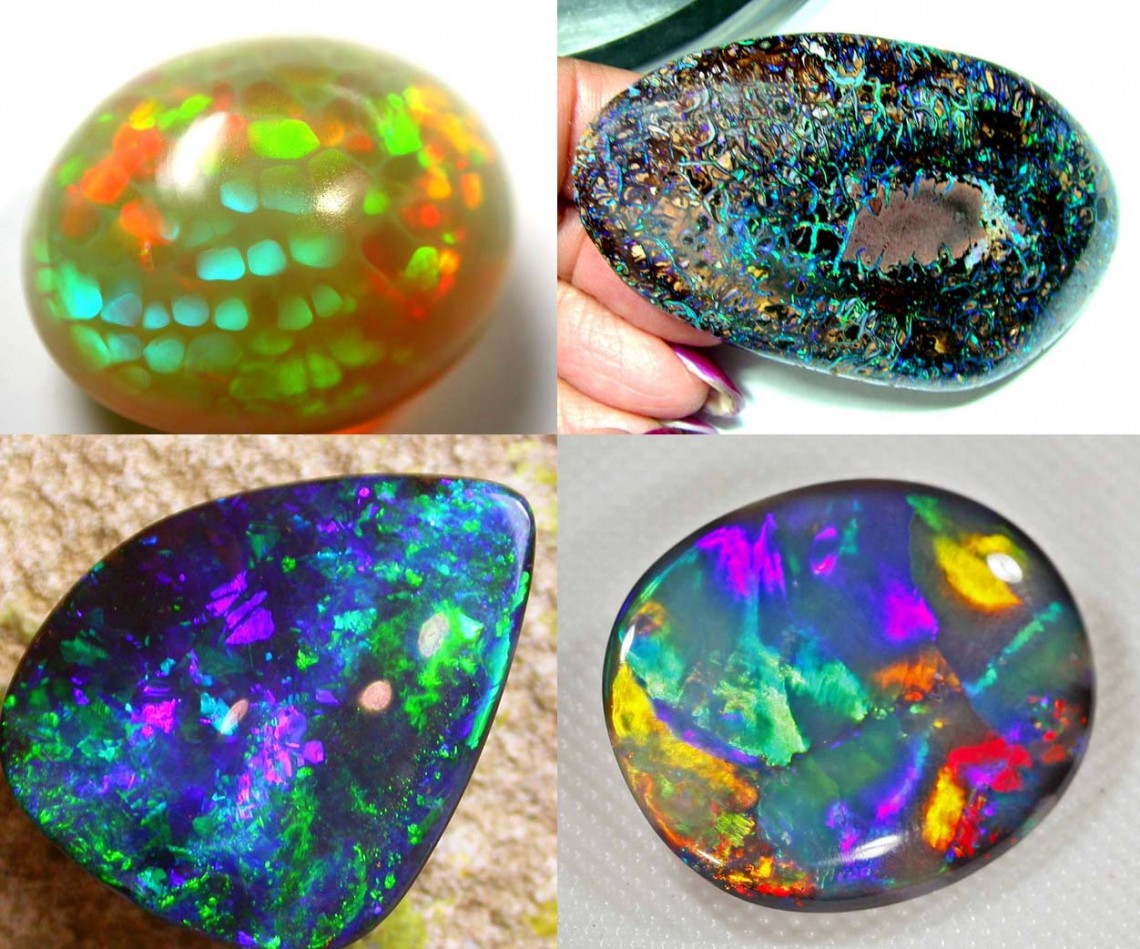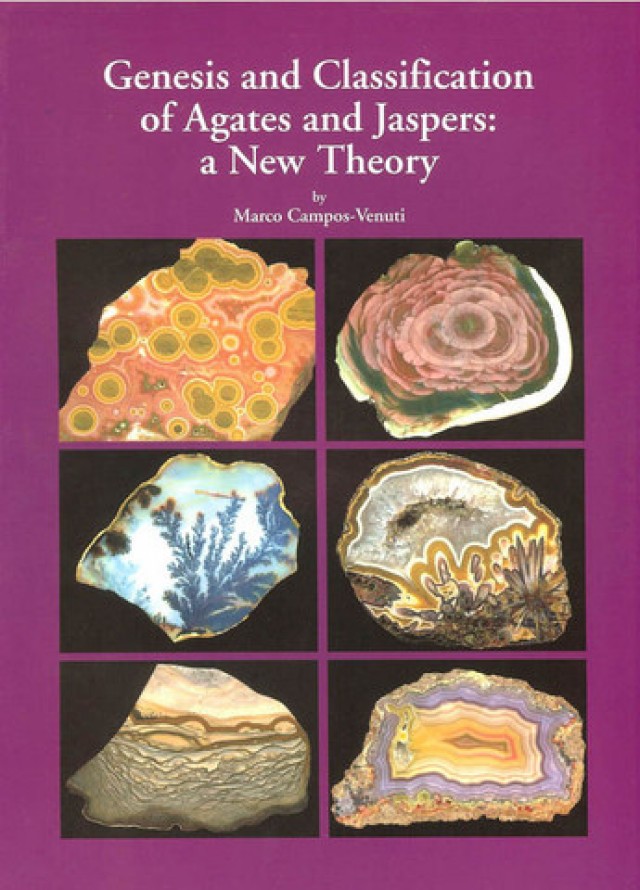
Gepubliceerd op 8th May 2018
Gewijzigd op 17th Nov 2025
Hoe ontstaat opaal?
 Als voormalig opaalmijnwerker had ik de neiging deze vraag te negeren, omdat mijn rol was om de schoonheid van de steen te promoten en niet een chemische analyse ervan. Er is nog steeds geen algemene overeenstemming over hoe het gevormd wordt en zelfs niet hoe oud het is. De gangbare theorie bij Lightning Ridge was dat silicaathoudend water door de zandsteen sijpelde en holtes en scheuren opvulde. Het water verdampte vervolgens en de opaalgel stolde.
Als voormalig opaalmijnwerker had ik de neiging deze vraag te negeren, omdat mijn rol was om de schoonheid van de steen te promoten en niet een chemische analyse ervan. Er is nog steeds geen algemene overeenstemming over hoe het gevormd wordt en zelfs niet hoe oud het is. De gangbare theorie bij Lightning Ridge was dat silicaathoudend water door de zandsteen sijpelde en holtes en scheuren opvulde. Het water verdampte vervolgens en de opaalgel stolde.
Bij de opaalvelden in Virgin Valley, Nevada (Verenigde Staten) [waar ook zwarte opaal wordt geproduceerd] zijn ze er echter van overtuigd dat er heet, met silica gevuld water omhoog is geduwd en de vegetatie heeft vervangen, waardoor opaal is ontstaan.
De lokale bevolking gelooft dat de opaal in Virgin Valley ongeveer 50.000 jaar oud is, terwijl wij altijd hebben aangenomen dat de opaal in Lightning Ridge 100 miljoen jaar geleden in het Krijt is gevormd. Dit blijkt uit de ontdekking van geopaliseerde dinosaurusbotten, planten en vissen.
Er wordt aangenomen dat het ongeveer vijf miljoen jaar duurde voordat ongeveer een centimeter opaal zich ontwikkelde. Mogelijk is dit gebeurd doordat regen de silicagel in de opaalgrond heeft gespoeld.
Dit was gebaseerd op de theorie dat de meeste fossielen die in Lightning Ridge werden gevonden, uit het Krijttijdperk kwamen.
Tegenwoordig zijn veel mensen echter van mening dat de fossiele openingen mogelijk pas veel later door opaal zijn vervangen. Sommigen suggereren zelfs dat het opaal minder dan 100.000 jaar oud is.

Boulder Opaal
Opaalblokken die in Queensland worden gevonden, ontstaan op een iets andere manier dan andere soorten Australisch opaal: ze vormen zich in een ijzersteenconcretie. De concretie is ontstaan door ionisatie door sedimentaire afzetting.
In de Idaho Spencer opaalmijnen in de VS was de opaaloplossing, of silica, een secundaire afzetting die ontstond door geiseractiviteit.
Door verschillende uitbarstingen gedurende een bepaalde tijd is de opaal in lagen opgebouwd. De meeste lagen zijn dun, wat resulteert in een van de mooiste tripletopalen ter wereld. De opaal wordt hydrothermisch afgezet in holle geodes in opeenvolgende lagen, waardoor Spenceropaal ideaal is voor tripletopalen, omdat de dunne lagen van extreem hoogwaardige, kostbare opaal zeer transparant zijn en een grote kleurintensiteit hebben.
CHEMISCHE OMSTANDIGHEDEN
De chemische omstandigheden die verantwoordelijk zijn voor de productie van opaal worden nog steeds onderzocht, maar sommigen beweren dat er in een bepaald stadium van het proces zure omstandigheden moeten zijn om silicabolletjes te vormen, mogelijk geproduceerd door microben. Ook wordt aangenomen dat aluminiumoxide, ijzeroxide of magnesiumoxide aanwezig moeten zijn, en natriumchloride of natriumsulfaat.
De NSW Primary Industries hebben gesuggereerd dat microben mogelijk zelfs een rol spelen. Ten tijde van de afzetting van de Krijtsedimenten vormden overvloedige organische stoffen en montmorilloniet (smectiet) klei in sommige sedimenten een ideale habitat voor de microben om zich te voeden en voort te planten. Afvalzuren en enzymen die door de microben werden uitgescheiden, veroorzaakten de chemische verwering van kleimineralen en veldspaat in de omliggende rotsen. Uiteindelijk creëerden de voortdurende voedings- en afvalproductieprocessen van de microben gunstige fysische en chemische omstandigheden voor de vorming van opaal.
GROEIENDE OPAAL
Opaal wordt gekweekt in potten met behulp van een elektrolyt (een chemische oplossing die elektrisch geladen is), waardoor het weken kan duren voordat er kleur zichtbaar wordt. Het is slechts een gel en niet uitgehard. Men denkt dat dit proces in de natuur voorkomt en dat het zou verklaren hoe opaal in vulkanische tufsteen of in het midden van een pit terecht is gekomen.
CSIRO-ONDERZOEK NAAR DE KLEURVORMING VAN OPAAL
Met behulp van een elektronenmicroscoop ontdekte Dr. Sanders dat opaal bestaat uit miljoenen kleine silicabolletjes in een regelmatig patroon. Tussen elk van deze bolletjes bevonden zich nog kleinere gaatjes of spleten, waardoor licht wordt afgebogen. Dat wil zeggen, wanneer wit licht of gewoon zonlicht door de gaatjes schijnt, wordt het in kleuren gesplitst. Bij opaal, waar de bolletjes klein waren, waren de kleuren de donkerdere kleuren van de regenboog: violet, indigo en blauw. Bij grote bolletjes ontstonden gele, oranje en rode kleuren. Kostbare opaal wordt gevonden wanneer de bolletjes in een regelmatig patroon liggen. Bij potch- of gewone opaal is er geen vast patroon. Het lijkt erop dat opaal op verschillende locaties door veel verschillende invloeden is gevormd om opaal te produceren met een uniek karakter uit dat veld. Ik ben nog steeds van mening dat het een mysterie of magie van aard is, dus laten we genieten van de schoonheid ervan.
Hoe opaal ontstaat - Meningen van een vulkanoloog
Auteur Marco Campos Venuti heeft zojuist een nieuw boek geschreven met de titel "Genesis en classificatie van agaten en jaspers". De auteur is een gepromoveerd vulkanoloog en auteur van de Gemmologica Italiana. Dank aan Marco Campos voor de toestemming om te publiceren.

Opaal is een geharde silicagel met de formule SiO2.nH2O, afkomstig van een geconcentreerde oplossing. In de levende organismen die organisch opaal produceren, zoals diatomeeën, radiolariën, sponzen en veel vaatplanten, hoopt kiezelzuur zich op in speciale cellulaire compartimenten waar specifieke eiwitten de neerslag van opaal-A induceren.
Het anorganische opaal daarentegen ontstaat door een combinatie van factoren. Een silicarijke bodem, zoals die in een vulkanisch gebied, of de aanwezigheid van kwartsrijk zand is noodzakelijk. Een zeer basische pH (>9) bevordert doorgaans de vorming van pekel bij een hoge concentratie kiezelzuur. Daarnaast hebben we grondwater nodig met sterke seizoensschommelingen in de grondwaterspiegel, wat de silicaconcentratie bevordert. Een katalysator is nodig om silica te laten neerslaan. Katalyse kan worden gestart door een temperatuurstijging, door een verschuiving naar een zure pH of door de aanwezigheid van moleculen zoals ijzeroxide, aluminiumoxide, magnesiumoxide, natriumsulfaat of simpelweg zeezout.
Wanneer een precursor van opaal is afgezet in de vorm van een viskeuze vaste stof, kan deze een porositeit hebben van meer dan 35%, gedeeltelijk ingenomen door water. Als het monster droogt, zou het verbrokkelen en onherstelbaar veranderen in een wit poeder. Dit is het grootste probleem bij de productie van synthetisch opaal. In het laboratorium is het noodzakelijk om deze porositeit te vullen met een hars die de optische eigenschappen van opaal niet verandert. In de natuur wordt andere silicagel gebruikt, die in de meeste gevallen de kwaliteit van het opaal vermindert. De transformatie van mineraal opaal tot jaspis kan ook worden aangestuurd door diagenese.

We zullen enkele van de bovenstaande termen in lekentaal uitleggen.
Diatomeeën
Diatomeeën zijn algen met kenmerkende, transparante celwanden die bestaan uit siliciumdioxide dat met een kleine hoeveelheid water (Si02 + H20) is gehydrateerd.
Radiolariërs
Het zijn amoeboïde protozoa die ingewikkelde minerale skeletten produceren
Kiezelzuur
(H4SiO4), is een belangrijke voedingsstof in de oceaan
Pekelwater
Pekel is een oplossing van zout in water. In verschillende contexten kan pekel verwijzen naar zoutoplossingen.
Anorganische opaal
Anorganische verbindingen worden traditioneel gezien gesynthetiseerd door middel van geologische systemen. Organische verbindingen daarentegen worden aangetroffen in biologische systemen.
Winkelen voor opalen
Zoek de Opal Encyclopedia
Gerelateerde veilingen
Laatste artikels
Ontdek hoe opalen worden beoordeeld en welke factoren hun prijs beïnvloeden. Van kleur en helderheid tot slijpvorm en oorsprong, leer hoe elk type opaal wordt gewaardeerd - met voorbeeldprijsklassen.
19th Jul 2023
Ga mee op reis en leer over de helende kracht van opalen van onze gastschrijver Vivien Schapera van Crystal Healing Techniques!
20th May 2023
De Vlam- (of Vuur-) Koningin-opaal is 's werelds duurste opaal en wordt tegenwoordig verkocht voor het equivalent van $ 3 miljoen. Leer alles over de geschiedenis en kwaliteiten ervan!
18th Feb 2023
Artikelcategorieën
All there is to know about Opals including Black Opals, Ethiopian Opals & Boulder Opal
14 Artikelen
Check out our fascinating information and articles on all things amazing in the Opal world
41 Artikelen
Opal Auctions sellers who are approved as opal Verified Sellers
4 Artikelen





![31.2 CTS 18K GOLD BLACK OPAL RING GOLD AND DIAMOND [CR01]](https://liveplatforms-production.b-cdn.net/tenants/oa/uploads/images/800000-804999/802924/5fd9cd62bf2db.jpg?width=480&aspect_ratio=1001%3A1000)


